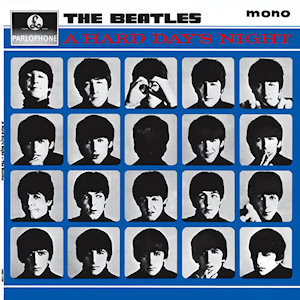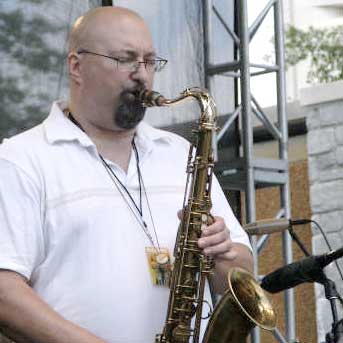If you’re looking for a way to discover some new music, check out Eclectic Mix. The show lives up to its name, featuring all kinds of music. For example, here’s a show with Latin Giants of Jazz and here’s one with The Monks and Choirs of Kiev Pechersk Lavra.
Music
Calendars, Connections, and Cats

James Burke had a television series Connections in which he would create a connection between two very different things. For example, in one episode he starts with the discovery of the touchstone for testing precious metals and tells a winding tale of how the touchstone led centuries later to the development of nuclear weapons.
I had a Connections-like moment when a calendar led to some physics, which then lead to Andrew Lloyd Webber’s musical Cats.
A few days ago I stumbled on Ron Doerfler’s graphical computing calendar and commented on the calendar here. When I discovered Ron Doerfler’s blog, I bookmarked his article on Oliver Heaviside to read later. (Heaviside was a pioneer in what was later called distribution theory, a way of justifying such mathematical mischief as differentiating non-differentiable functions.) As I was reading the article on Heaviside, I came to this line:
At one time the ionosphere was called the Heaviside layer …
Immediately the lyrics “Up, up, up to the Heaviside layer …” started going through my head. These words come from the song “The Journey to the Heaviside Layer” from Cats. I had never thought about “Heaviside” in that song as being related to Mr. Heaviside. I’ve never seen the lyrics in print, so I thought the words were “heavy side” and didn’t stop to think what they meant.
Andrew Lloyd Webber based Cats on Old Possum’s Book of Practical Cats by T. S. Eliot. The song “The Journey to the Heaviside Layer” in particular is based on the poem Old Deuteronomy from Eliot’s book. Webber used the Heaviside layer as a symbol for heaven, based on an allusion in one of T. S. Eliot’s letters. The symbolism is obvious in the musical, but I hadn’t thought about “Heaviside layer” as meaning “the heavens” (i.e. the upper atmosphere) as well as heaven in the theological sense.
The opening chord of "A Hard Day’s Night"
The opening chord of the Beatles song “A Hard Day’s Night” has been something of a mystery. Guitarists have tried to reproduce the chord with limited success. Turns out there’s a good reason why they haven’t figured it out: the chord cannot be played on a guitar alone.

Jason Brown has digitally analyzed the chord using Fourier analysis and determined that there must have been a piano in the recording studio playing along with the guitars. Brown has determined what notes each member of the Beatles were playing.
I heard Jason Brown’s story on the Mathematical Moments podcast. In addition to the chord discussed above, Brown talks about other things he has discovered about the Beatles and about the relationship between music and math in general. Unfortunately, Mathematical Moments does not make it easy to link to individual episodes. Here is a link to a PDF file of show notes with the audio embedded. The file is slow to download, and your PDF viewer may not support it. Here’s a link directly to just the MP3 audio file.
The Mathematical Moments podcast also does not make it obvious that you can subscribe to the podcast; they only provide links to individual episodes with fat PDF files. However, you can subscribe by using the URL http://www.ams.org/rss/mathmoments.rss.
Update: Here’s a paper that goes into some details.
Circle of fifths and number theory
Why does music have a circle of fifths but no circle of thirds or circle of sixths?
If you start at on any note and go up by fifths, you’ll cycle through the entire chromatic scale. For example: C, G, D, A, E, B, F#, C#, G#, D#, A#, F, C. If you go up by fourths, you’ll get the same sequences of notes but in the reverse order. So there’s a cycle of fifths and a cycle of fourths, but there are no other ways to cycle through the chromatic scale other than the chromatic scale itself.
If you start at C and go up by minor thirds, for example, you’ll only hit four distinct notes before returning to where you started: C, D#, F#, A, C. You don’t cycle through all 12 notes, only four of them. Instead of filling out a chromatic scale, you fill out a diminished chord. You could fill out two other diminished chords by starting on C# or on D. Going up by major sixths produces the same sequence of notes as going down by minor thirds.
What’s special about fourths and fifths that their cycles cover the chromatic scale while cycles of other intervals partition the chromatic scale into smaller groups of notes? A fourth is 5 chromatic steps and a fifth is 7 chromatic steps. The numbers 5 and 7 are relatively prime to 12, that is, they share no factors with 12 (other than 1, which doesn’t count).
The numbers less than 12 and relatively prime to 12 are 1, 5, 7, and 11. These intervals correspond to the ascending chromatic scale, the circle of fourths, the circle of fifths, and the descending chromatic scale.
The numbers less than 12 and not relatively prime to 12 are 2, 3, 4, 6, 8, 9, and 10. Going up by 2 chromatic steps produces a whole-tone scale. Going up by 10 steps produces the same sequence of notes but in the opposite order. Going up by 3 or 9 steps produces a diminished chord. Going up by 4 or 8 steps produces an augmented chord. Going up by 6 steps produces a tritone pair. (I’m used to jazz terminology which uses the term “tritone.” Classical musicians would more likely say “augmented fourth” or “diminished fifth.”)
Now imagine a non-traditional scale that divided the octave into some number of parts other than 12. Suppose this new scale has n notes. Cycling in steps of size m will cover all n notes if and only if m and n are relatively prime. For example, if we divide the scale into 15 parts, we could cover all 15 pitches if we went up 4 steps at a time. We could play notes 1, 5, 9, 13, 2, 6, 10, 14, 3, 7, 11, 15.
If m and n are not relatively prime, let d be their greatest common divisor, the largest number that divides both m and n. Then going up d parts at a time will cycle through m/d notes and there will be d distinct cycles. For example, if there were 15 notes in our scale and we went up in intervals of 10 notes, we would cover 3 distinct notes, and we could make 5 different such three-note chords. For example, one such chord would be notes 1, 11, and 6, and another would be notes 2, 12, and 7.
If a scale had a prime number of notes, then every interval (other than an octave) would cycle through all notes.
Why is the 12-note scale so common? There have been other systems, but these are mostly subsets (at least approximately) of the 12-note scale. The answer seems to have something to do with the fact that intervals in the 12-tone scale have simple frequency ratios. For example, a fifth is a ratio 3:2 and a forth is a ratio 3:4. (More on that here.) These intervals are pleasant to our ears. There was a prehistoric flute in the news a few weeks ago and it appears to have been based on the same musical intervals common in modern music.
Related posts
Circle of fifths and roots of two
A chromatic scale in Western music divides an octave into 12 parts. There are slightly different ways of partitioning the octave into 12 parts, and the various approaches have long and subtle histories. This post will look at the root of the differences.
An octave is a ratio of 2 to 1. Suppose a string of a certain tension and length produces an A when plucked. If you make the string twice as tight, or keep the same tension and cut the string in half, the string will sound the A an octave higher. The new sound will vibrate the air twice as many times per second.
A fifth is a ratio of 3 to 2 in the same way that an octave is a ratio of 2 to 1. So if we start with an A 440 (a pitch that vibrates at 440 Hz, 440 vibrations per second) then the E a fifth above the A vibrates at 660 Hz.
We can go up by fifths and down by octaves to produce every note in the chromatic scale. For example, if we go up another fifth from the E 660 we get a B 990. Then if we go down an octave to B 495 we have the B one step above the A 440. This says that a “second,” such as the interval from A to B, is a ratio of 9 to 8. Next we could produce the F# by going up a fifth from B, etc. This progression of notes is called the circle of fifths.
Next we take a different approach. Every time we go up by a half-step in the chromatic scale, we increase the pitch by a ratio r. When we do this 12 times we go up an octave, so r12 must be 2. This says r is the 12th root of 2. If we start with an A 440, the pitch n half steps higher must be 2n/12 times 440.
Now we have two ways of going up a fifth. The first approach says a fifth is a ratio of 3 to 2. Since a fifth is seven half-steps, the second approach says that a fifth is a ratio of 27/12 to 1. If these are equal, then we’ve proven that 27/12 equals 3/2. Unfortunately, that’s not exactly true, though it is a good approximation because 27/12 = 1.498. The ratio of 3/2 is called a “perfect” fifth to distinguish it from the ratio 1.498. The difference between perfect fifths and ordinary fifths is small, but it compounds when you use perfect fifths to construct every pitch.
The approach making every note via perfect fifths and octaves is known as Pythagorean tuning. The approach using the 12th root of 2 is known as equal temperament. Since 1.498 is not the same as 1.5, the two approaches produce different tuning systems. There are various compromises that try to preserve aspects of both systems. Each set of compromises produces a different tuning system. And in fact, the Pythagorean tuning system is a little more complicated than described above because it too involves some compromise.
Related post: Circle of fifths and number theory
Saving up for an avocado
Ellen Finn describes how she quit her job and exhausted her retirement savings to become a musician when she was around 50 years old.
I was totally broke. I was living on beans and I know thousands of bean recipes. It’s scary at any age, but it’s particularly scary in your fifties when all my friends are retiring and my goal is to save up for an avocado.
The quote comes from the BrightSideBroadcast podcast featuring her music.

Pentatonic scale demo with Bobby McFerrin
Amazing jazz musician
Brian Lopes is amazing. I’d never heard of him until he was featured on the Eclectic Mix podcast a few days ago. The podcast describes his music “a high energy expedition crossing from jazz to R&B to funk and back again.” On his website, Brian Lopes lists as his influences John Coltrane, Michael Brecker, Wayne Shorter, David Sanborn, and Cannonball Adderly. These are some of my favorite musicians, and listening to Lopes is like listening to all of these at once.

Apparently he only recently started recording with his own group, the Brian Lopes Trio. According to the podcast, Brian Lopes has played with Chick Corea, Frank Sinatra, Aretha Franklin, Ray Charles, and other well known musicians. Finding his music is difficult, but you can buy his first CD at Blue Canoe Records. (Apparently you can’t actually buy a physical CD, but you can buy the MP3 files, sans DRM, that make up the CD.)
Image credit: Eclectic Mix podcast
Related posts
Music recommendations
[This page has been removed.]
Best podcast intro music
Here are three of my favorite podcast intro themes.
.NET Rocks by Carl Franklin and Richard Campbell.
Carl Franklin composed the intro theme, Toy Boy, and recorded the song with his brother Jay. The tune is catchy, the words are clever, and Carl’s a great musician. Richard and Carl talk over the intro, but you can hear these odd phrases poking out, such as “got a transmitter banned by the FCC.” After listening to the podcast for a while, I decided I had to find the theme song and listen to Toy Boy without the voice overs. Here’s more music by Carl Franklin.
Hanselminutes by Scott Hanselman.
The theme song is just a short loop, but it’s fun music. I wrote Scott a note asking him about the intro. I was hoping the loop taken from a longer song I could buy somewhere and thought I’d like to find more music by the same composer. Scott said that his theme song was written for his podcast by Carl Franklin. I was surprised that Carl came up again, but this isn’t totally unexpected since Carl’s company Pwop Productions produces Hanselminutes.
Accidental Creative by Todd Henry.
The theme song is My City In Healing from A Slave Left Dreaming by Joshua Seurkamp. The song is a blend of Eastern and Western music, appropriate for a podcast that emphasizes creatively combining ideas.
I also wanted to mention the theme from the Science Magazine podcast. It’s not music I particularly enjoy listening to, but it is written in 5/4 time, something that has come up for discussion on this blog.
Related post: Interview with Carl Franklin
